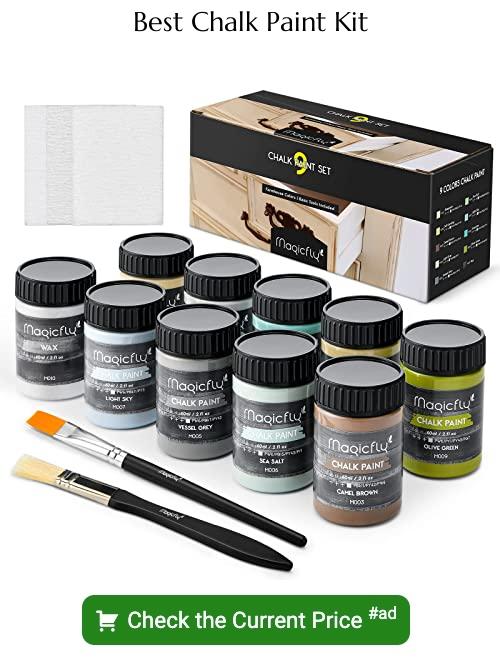Last updated on
Learn how to create your own chalk paint with this simple homemade recipe, perfect for giving furniture and decor a matte, vintage look.
Key takeaways:
- Choose a flat or matte latex paint for best results
- Experiment with different paint colors for unique effects
- Use a fine powder form of calcium carbonate for a smooth finish
- Mix Plaster of Paris in small, usable batches to prevent setting
- Use a measuring cup for precise measurements and reliable results
SUPPLY LIST
Before embarking on your chalk paint creation, gather the following essentials:
- Latex paint: The base of your chalk paint, choose a flat or matte finish for best results.
- Calcium carbonate: This natural mineral will give your paint the desired chalky texture. Look for it in the supplement aisle or a homebrew shop.
- Plaster of Paris: An alternative to calcium carbonate, this will thicken the paint and help it adhere better to surfaces.
- Measuring cup: Precision is important, so measurements need to be exact for the right consistency.
- Mixing bowl: Opt for a sizeable mixing bowl to blend your ingredients thoroughly without spilling.
Selecting the right paint color and making sure your supplies are ready will pave the way for a successful DIY chalk paint project.
Latex Paint
Choosing the right latex paint forms the base for your homemade chalk paint. Opt for a flat or matte finish, as it blends well with the additives to create that sought-after chalky texture. Aim for non-toxic, zero-VOC options if you’re looking for an environmentally friendly choice.
Consider the color selection; pastels and lighter shades often underscore the chalky effect, but don’t be afraid to experiment with darker hues for bold statements on your furniture.
In terms of quantity, a sample pot is often sufficient for small projects, like a side table. For larger pieces, such as wardrobes or cabinets, a quart will be necessary. Remember, it’s better to mix a bit more than you think you’ll need than to interrupt your workflow to make another batch.
Calcium Carbonate
Calcium carbonate, a widely available and versatile compound, plays a critical role in creating your DIY chalk paint. It’s responsible for giving your paint the desirable matte finish and the superb ability to stick to almost any surface without the need for a primer.
When incorporating calcium carbonate into your paint mixture, ensure that you:
- Use a fine powder form for a smooth finish.
- Sift it to remove any lumps that could mar the paint’s texture.
- Mix it thoroughly with water to create a paste before blending with the latex paint to avoid a gritty texture.
By following these simple guidelines, calcium carbonate can transform regular latex paint into a highly adhesive and easily sandable chalk paint, perfect for achieving that coveted shabby chic look on your furniture pieces.
Plaster of Paris
When incorporating Plaster of Paris into your chalk paint recipe, achieving the right consistency is crucial for the smooth application. Start with a ratio of three parts paint to one part Plaster of Paris, combining them until you have a lump-free mixture.
Be mindful that Plaster of Paris sets quickly, so mix in small, usable batches and start painting without delay. It’s also essential to use cool water when initially mixing the plaster to prevent it from heating up and setting too fast.
If the mixture thickens as you work, simply stir in water, a tablespoon at a time, until it returns to a creamy consistency. Remember to clean your brushes immediately after use, as the Plaster of Paris can solidify in the bristles, rendering them unusable.
Measuring Cup
Having the right proportions is key to achieving the perfect texture for your homemade chalk paint. Use a measuring cup to ensure that you accurately follow the recipe, as the consistent ratio of latex paint to calcium carbonate or Plaster of Paris will determine the coverage and chalkiness of your paint.
Remember, exact measurements lead to reliable results, so be precise. A clear measuring cup with marked gradations is ideal for making these measurements easy and visible at a glance. Keep in mind that for smaller projects, you may need to convert measurements to appropriately scale down the recipe.
Recap:





